BRING BACK BETTY MACDONALD!
The David Sedaris of her day: author of "The Egg and I" and three more stellar memoirs
As popular in her day as David Sedaris—and every bit as funny—Betty MacDonald (1908-1958) retains a small but devoted following of which I’m a proud member.
She’s perhaps best known as the author of The Egg and I (1945), the book that gave rise to the characters Ma and Pa Kettle.
But as the gap between the rich and the poor grows ever wider, the book I’m turning to again is called Anybody Can Do Anything (1950).
It’s about Seattle during the Depression and Betty's wacky family—they’re all back home, living with the chain-smoking, novel-reading, mild-mannered mother—which is headed up by the oldest sibling, Mary, and how Mary gets Betty, who is divorced with two young daughters, a succession of odd jobs for which Betty is completely and utterly unqualified.
Here's the conversation that ensues after Mary announces to Betty that she's volunteered her for a job "at the Western Insurance Company being private secretary to a perfectly darling man named Welton Brown":
“I tried to keep my voice normal as I asked, ‘Just what have you told this Welton Brown I could do, Mary?’
Mary said, ‘Stop interrupting and you'll find out. Because Welton gets out a magazine, his secretary has to be able to type and take shorthand, know all about insurance, be familiar with advertising and layouts, draw well enough to illustrate the magazine and be able to write and edit articles. He'd really prefer someone who's been published.’
‘Well,’ I said, ‘A--I'm only mediocre to rotten in shorthand and typing; B--I don't know anything about advertising or layouts; C--I majored in art in college but we never drew anything but plaster casts; D--I can't write and I've never had anything published and all my insurance information is mixed up with chickens.’
Mary said, ‘Listen, Betty, I've known you for twenty-four years and you've never thought you could do ANYTHING. Now there's a depression and jobs are hard to find and you've got two children to support and it's about time you grew up and changed your thinking to things you can do instead of things you can't do. Mull over your talents and build up your ego.’ “
Mary then smartly rebuts each of Betty’s objections, ending with ‘E--You have to be able to write and that is one thing you have to admit you can do. What about your children's stories--what about 'Sandra Surrenders'--I'll bet the Ladies' Home Journal would snap it up if we ever finished it."
In short, this is an essential, useful book, recession or no. Its complete lack of self-pity and huge sense of fun (“No-one likes a saddo,” Betty’s mother counsels) are character attributes to which we should all aspire.
Betty ends up working as a photo tinter, an organizer for a rabbit grower, and a typer of bills for a florist.
She works for an oil promoter, a dentist, a Mr. Wilson who runs a pyramid scheme, and a gangster.
Mary's also constantly setting Betty up on gruesome blind dates, and as the two of them good-naturedly dismiss the guy with roving hands as "Oh that old raper," and the elderly lech as "Probably just some lonely old buzzard who wants to meet some girls," I couldn't help reflecting upon how much we've lost in our own era of humorless political correctness.
For fun, the sisters (there are four of them, plus one brother) put on a pot of spaghetti, invite a crowd of artistes--some of whom end up staying for years--and crowd around the gramophone or piano singing, making fun of each other, smoking, drinking endless cups of coffee, and putting on plays.
Actually, everyone in Betty's family, including her, chain-smoked, which probably did not help stave off the TB that sent her to the sanitarium for nine months and resulted in the also delightful memoir (purportedly her own favorite) The Plague and I (1948).
Here's her breezy allusion to that little life hiccup:
"I finally collapsed with tuberculosis and was wheeled away from the Treasury Department. When I got well again I went to work for the National Youth Administration. The NYA and Mary would have seen eye to eye about a lot of things. Executives for instance. Mary believed that everybody but our collie was a potential executive and the NYA proved it. "
In another Anybody Can Do Anything chapter--"All the World's a Stage"--Betty expounds on the free entertainment to be had by going about the city with her sister Dede ferreting out amateur dance and song recitals:
"Then Miss Grondahl announced that she would play ‘Rustle of Spring’ and ‘Hark, Hark the Lark’...Miss Grondahl was a vigorous very loud player but what made her performance irresistible to Dede and me were the large tufts of black hair which sprang quivering out of the armholes of her dress each time she lifted her hands at the end of a run or raised her arms for a crashing chord."
Eventually, Betty re-marries, moves to Vashon Island, off the coast of Washington state, and begins working for a contractor with cost-plus government contracts.
She would later write Onions in the Stew about her time there.
First, though, Mary convinces Betty to write a book about her adventures on the remote chicken ranch to which she'd earlier moved with her first husband: a marriage that had ended when Betty matter-of-factly packed up two young daughters one rainy morning, walked down the hill, and boarded a bus for Seattle, never to return.
The book—The Egg and I—was accepted by J. B. Lippincott, serialized in the Atlantic Monthly, was number one on The New York Times non-fiction bestseller list for 43 weeks, and the rest is history, thereby proving Mary's theory that anybody can do anything. Or as she triumphantly told Betty, "You just feel successful, but imagine how I feel. All of a sudden my big lies have started coming true!"
Would that we all had a sister Mary. And long live Betty MacDonald.
I was thrilled on a trip to Vashon Island several years ago to spend two nights at the Betty MacDonald Farm. The very house where she and Don, her second husband, lived, still stands. The barn above the house has been converted to a B and B with a view of Puget Sound and a fir tree with a nesting bald eagle.
A woman named Judith Lawrence ran it at the time (and may still) and if you wanted to reserve a room, you had to call and talk to her so (I surmised) she could make sure you weren’t crazy or a kvetcher. I had a lovely half-hour chat with her on the phone before booking, after which she mailed me an envelope containing a hand-written note, brochures, maps and a ferry schedule with the appropriate routes high-lighted. Old school!
I stayed in the "Cedar Loft" on the third floor of the gambrel-roofed barn in which Betty, in spite of her earlier poultry mishaps, apparently continued to raise chickens. An entire wall of east-facing windows overlooked the Sound. There was a deck with chairs, tables, and a pair of binoculars. There were daffodils, tulips, and flowering Asian pear trees. The air was thick with birdsong. The loft was filled with kilim rugs, daybeds, stacks of books on Native Americans, gardens, birds, antiques, architecture, and of course titles by Betty MacDonald.
Plus the place had a fully and I mean fully stocked kitchen, as in piles of linen napkins, votive candle holders, nutcrackers, corkscrews, English ceramic cream pitchers, and in the fridge organic eggs, good coffee, half-and-half, butter and English muffins. Good wifi, high comfy bed, masses of extra blankets and comforters, a wood stove and cords of split wood, cloisonné containers holding boxes of classy wood matches. Two huge arrangements of freshly-cut camellias.
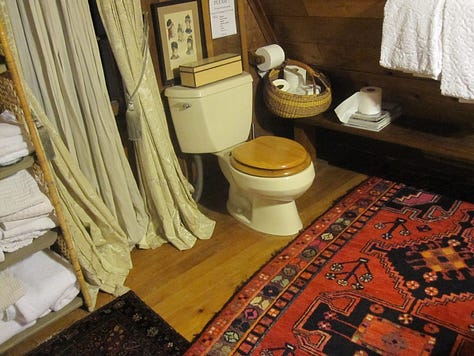
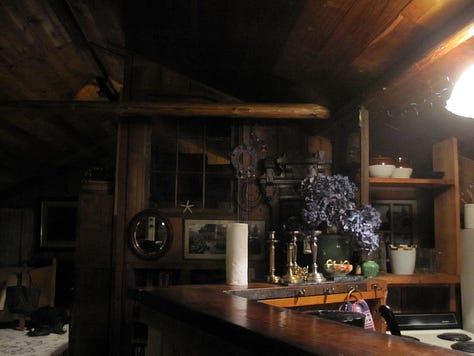

The room wan’t even that expensive (otherwise, I wouldn’t have stayed); the way I remember it, I was in Seattle to give a 12-step retreat and couldn’t resist the opportunity to make a side pilgrimage to Vashon.
Betty was apparently a wonderful cook and a hostess extraordinaire (especially on Vashon which was of course a popular spot for Seattle-ites who wanted to get away for the weekend). So the whole feel of the place brought Onions in the Stew in particular alive in a new way.
Later I came across the biography Looking for Betty Macdonald, by Paula Becker, which is full of delicious backstory, for instance that Betty’s first husband was eventually murdered by what could have been a love rival; that Don, the second husband was handsome and charming and sort of of didn’t work, ever hardly, thereby making Betty the family breadwinner; and that Betty had been embroiled in a nasty libel suit brought by the Bishops, the family they alleged (and Betty denied) had served as the model for Ma and Pa Kettle.
Through it all, Betty gardened, cooked, entertained, raised two daughters, wrote in whatever moments she could snatch from her other duties, and maintained a joie de vivre and sense of humor that I, for one, tremendously admire.
Sometimes you just need an incredibly intelligent, incredibly well-written, book that makes you laugh. When on the verge of despair, I have often dipped into a random page or two of Betty, snickered away, and been restored to sanity—or close enough to keep living another day.
Can we ask any more of an author?
She and Don moved to Carmel in 1956. Betty came back to the Pacific Northwest for treatment and died in Seattle of uterine cancer on February 7, 1958.

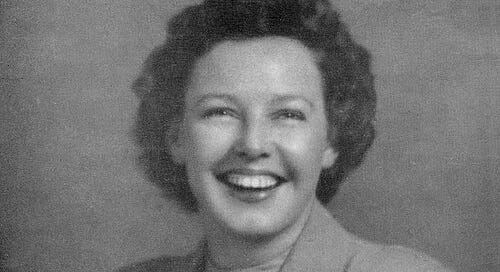



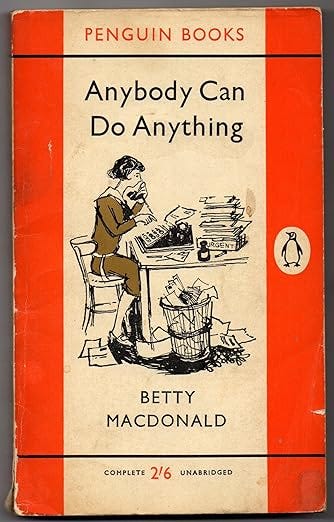
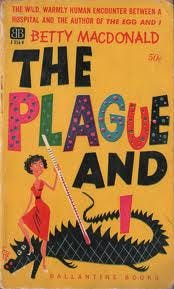
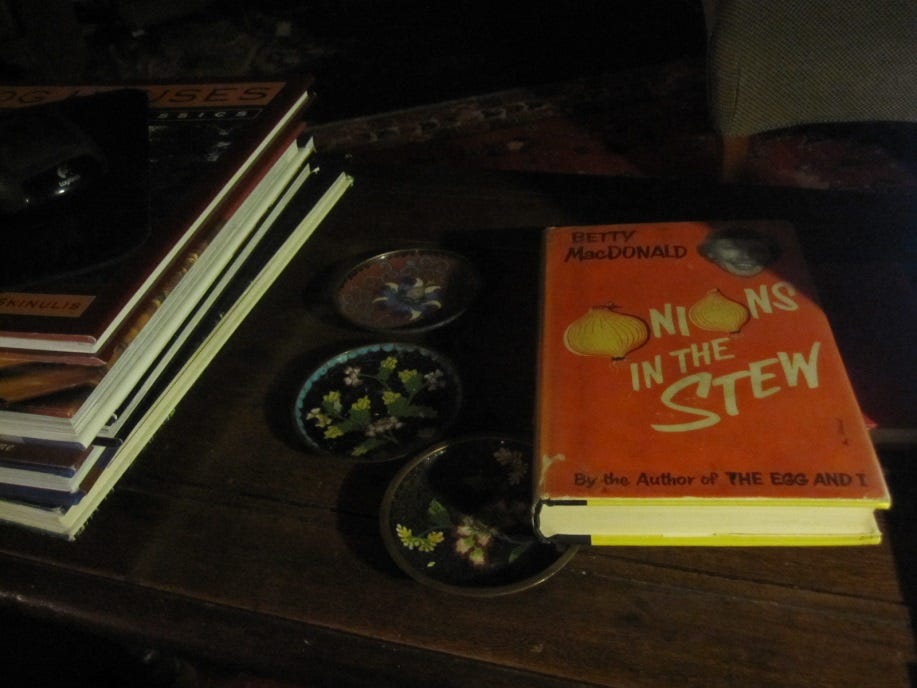
I have loved Betty Macdonald for ages. Thank you for reminding me to re-read them.
Loved her Mrs Piggle-Wiggle books for read a loud for my first graders. Though I had to explain some references for modern little minds.